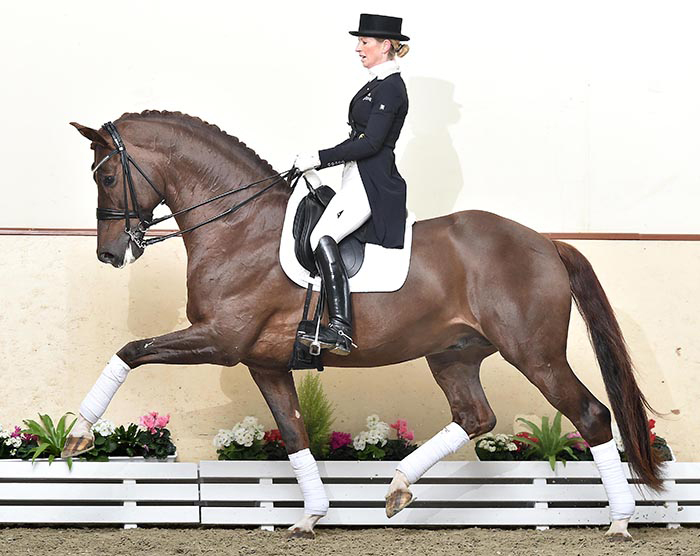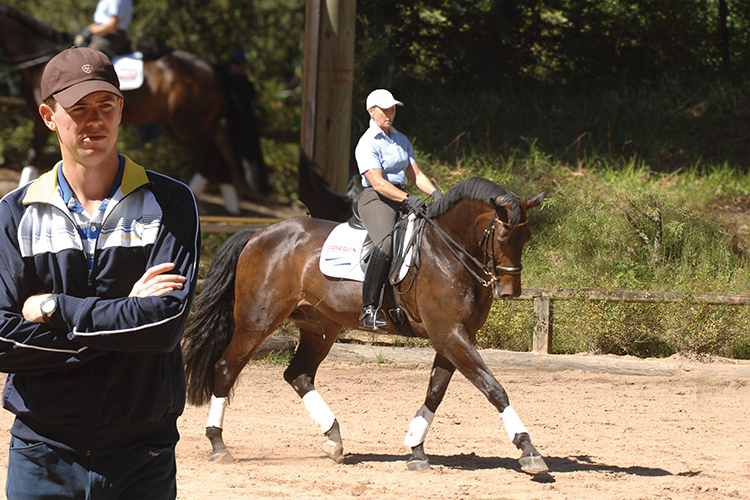 One of the many intriguing things about the equestrian art is that it is both simple, and complex, at the same time. Good training is really quite simple, but it only works when applied with great discipline, tact and subtlety – which is why real dressage instructors sometimes sound like Buddhist monks who specialise in riddles like ‘listen to the sound of one handed clapping’.
One of the many intriguing things about the equestrian art is that it is both simple, and complex, at the same time. Good training is really quite simple, but it only works when applied with great discipline, tact and subtlety – which is why real dressage instructors sometimes sound like Buddhist monks who specialise in riddles like ‘listen to the sound of one handed clapping’.
In Stefan Wolff’s case the real bonus is that Stefan is primarily a rider. After several years working as Bereiter for Klaus Balkenhol, Stefan is now based in a new barn in the United States, where once again, his main job is riding horses – teaching students is a bonus. It is a tribute to the thoroughness of the German system, and to Stefan’s intelligence, that even working in a second language he is such a subtle and effective teacher.
When I caught up with him on his third visit to Clemens and Judy Dierks’ training stables in the heart of Sydney’s dressage belt. It meant that Stefan had been working over a period of time with Judy and her then FEI front-liner, HP Frontier.
It’s so nice when ducklings turn into swans, and it must be confessed that as a youngster, Frontier was a bit of a gawky duck – a goose even – so how nice it is, that with the correct work and training, he is now emerging swan-like, as one of the most exciting young Grand Prix horses in Australia, and at the age of just eight, he has the Special Championship from the most recent CDI to prove it.
So this horse is the result of team work, the Dierks team, Clemens and Judy have produced a series of Grand Prix horses, but this time there is a little added something in the mix, the regular visits to the Dierks Training stables of Stefan Wolff.
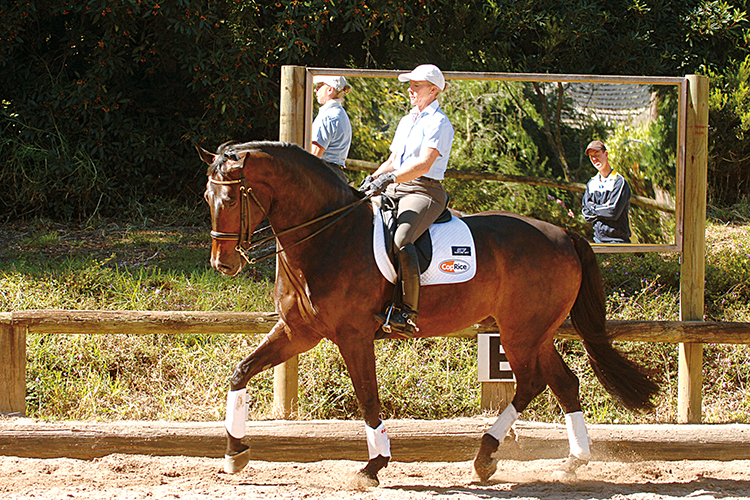
Like his mentor, Klaus Balkenhol, Stefan is absolutely determined that the horse is thoroughly relaxed and through before the work can begin.
“Give, then work him from behind. Don’t hold him down, keep it light, then remind him to work from behind through his body – the neck is only transferring it to the hand. Lighten Judy, there, only now can you start.”
And start they do, the gelding has acquired a new dimension of power and athleticism since last I saw him. When he is thoroughly worked in, Stefan decides to check the progress since their last meeting…
“Now go to passage but keep him working low with a very light rein…”
But the minute Judy tries to take this softness and throughness to the passage, Frontier loses it: “He is up in the neck and blocking the body – your hand is only influencing the neck and not the movement. Go to walk, walk, passage, walk, get his neck out again. Now go out in trot, he is light and from behind again. Back to passage, but keep his body involved, don’t let him suck back. He needs to be more oriented forward, no matter how much you bring him back.”
That’s the first of Stefan’s mind-bogglers. “We want the horse more forward, no matter how much we bring him back…” Solve that and you hear the that one hand clapping.
But it does make sense, and Stefan emphasises the point: “When you feel the contact is fragile, don’t make the mistake of taking with the hand – close from behind. It’s not about pulling him up, it’s about keeping the neck low, and getting him to use the right muscles. Get him lower in the neck so you can have him more uphill.”
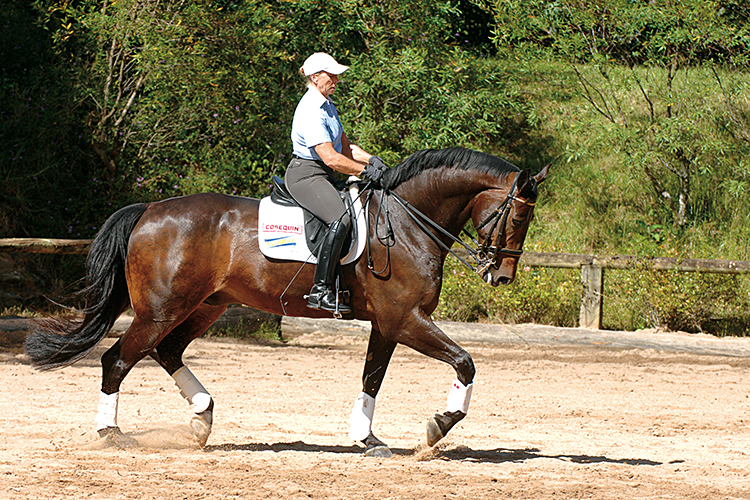
Stefan has spotted the slight irregularity of the rhythm, and suggests that it is because the horse is not really accepting the contact: “It’s good now, he’s not coming back and interrupting the rhythm when you touch him. School him so he can come to the hand.”
“Make sure that you do not start hesitating in passage. Work in the same manner as you do in walk or trot or canter, it’s just another movement. Think ‘trot’ in passage, think trot otherwise it gets very artificial. It is not just one boring passage, work the passage like you work the trot.”
“Don’t let him irritate you. Just keep doing the right aids, just keep going, there you go, now that is better. His body is involved, he is not tense, he is free with his body. Now piaffe. In piaffe, only the bit stays on the spot, the horse’s body keeps moving to it…”
Suddenly we have a beautiful sequence: passage / piaffe / passage…
“Good now get out of it and walk on a long rein.”
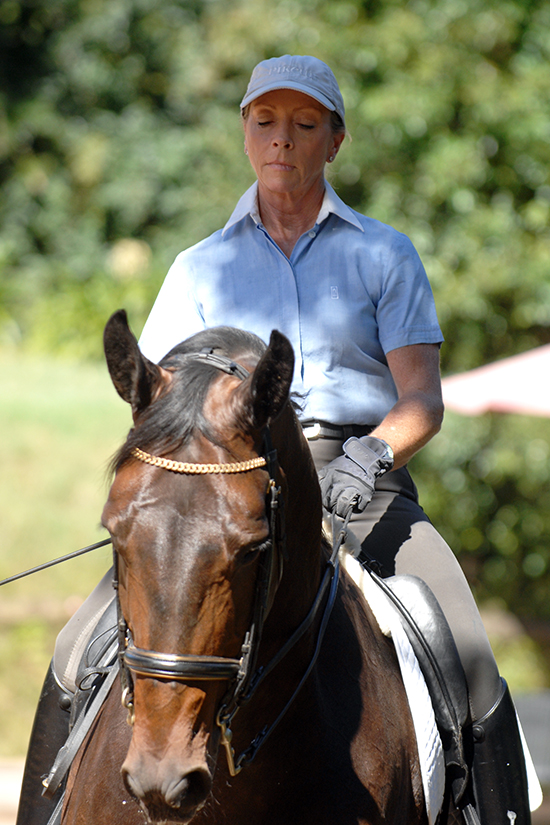
Later I discuss the lesson with Stefan…
With Judy it was a very interesting the problem that you were working on, when she started to try and use the reins, Frontier was ‘freezing’ and blocking and coming a little irregular, especially in the passage. What were you trying to get her to do to solve this problem?
“We see very often that the hand of the rider interrupts the movement of the horse – the hand influences the horse in a negative way. One of the most important things for the rider to work on, is to make sure movement is not affected by the hand. The rider always has to find a way to collect a horse, to work a horse, and you need your hand as an aid. The aim is to collect the horse, without getting less movement. So often when the rider goes to collect the horse, the movement gets less, it gets slower, or lazier, or even worse, the horse develops rhythm faults. The way must always be that the rider motivates the horse from behind and towards the bit, and then the rider can either give or restrain – so that the movement arrives in the hand and the horse can react, but it is not that the hand goes back towards the movement, it’s always the direction from behind, forward towards the hand.”
You were saying with Judy that when she went to passage she was losing the movement in her body that she has in the other paces…
“Horses react to riders more than we think. They feel when the rider gets stiff and hesitant up there. The horse’s body always follows the rider, and when the rider gets stiff that’s when the body of the horse also gets stiff and we end up in holding, pulling… Not that Judy is doing that, but it is a problem we should be aware of. You must keep working your horse relaxed, even in the higher movements.”
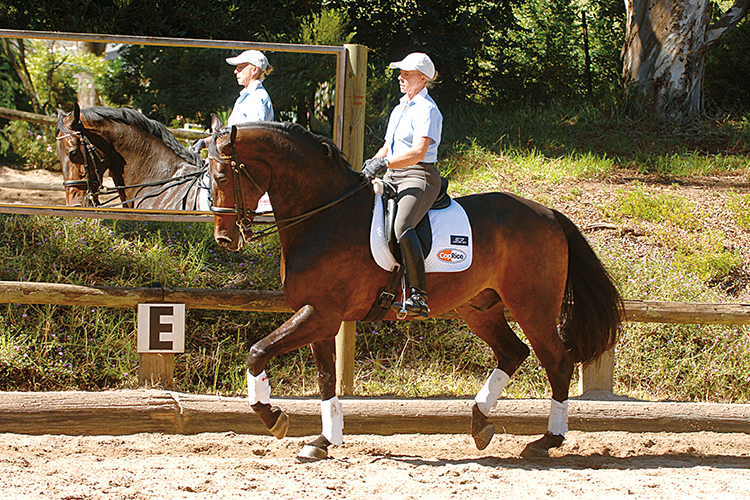
So the answer is to refresh – to go out of the collected movement?
“If you are in doubt, the answer is always, yes. If you get problems in the high collected movements, the safe way to fix the problem is in a working tempo. You can solve the problems there and then, if you have the horse supple and active again, then you can come back to the passage and then get the same work more-or-less that you get in the working trot.”
“When the horse gets crooked, especially in piaffe and passage, you often see irregular steps, especially in the hindlegs, which makes sense because one leg has to make a longer step than the other, so they get irregular. Often when a horse is irregular, the rider should check if it is really straight. A lot of times, all they need to do is straighten the horse, and then they get regular.”
You were working a lot trying to get the neck longer…
“The frame is always something that has to be taken care of very very well. A lot of horses are too tight, or not supple in the neck, which always has a bad influence on the natural balance of the horse, and further on the natural movement. The rider always has to take care that the frame is proper.”
You don’t use a lot of flexions to loosen the neck?
“I use flexions if necessary. Some horses for sure need to be worked in bend, but only for a short time. You can only bend a horse when it is working from behind towards the bit, then the hand can act. If the horse is not working properly from behind towards the hand, there is no reason to bend the horse – if you did that you would have to work backwards with your hand. The order is, the leg activates the horse, the horse swings towards the rein and then the hand can act – and not the other way. That was the problem here – I first wanted the horse to work more properly, more convincingly, towards the hand – then it is time to work. Then you can work more with your hand, but only when it is time.”
Do the legs have to keep asking all the time, or should you be able to put the horse forward and the horse keeps going forward?
“The leg, of course, stays in contact all the time to the horse’s body. It is best when the horse keeps working himself and you just have to keep the contact – but of course sometimes we have problems keeping the horse in front of the leg, then we have to keep reminding the horse and that is with our driving aid. Sometimes it can be less, and sometimes a bit more forward with your leg, to convince the horse and to motivate the horse to keep going. Every driving aid should have the result that after that driving aid, the horse is motivated to keep working on its own. The leg just keeps contact to control, and, if necessary, refresh the activity.”
And when you refresh with the leg, should you give with the hand?
“In general, yes. You can either release, or restrain. You have those two possibilities to ride into a releasing or restraining rein – but never into a rein that pulls back.”
You said to Judy in the piaffe, that only the bit stayed on the spot that the horse must keep moving in the piaffe…
“First of all the horse has to have a forward tendency in piaffe, we all know that. Also the problem came up that the horse was getting more passive in the piaffe than in passage. We actually want, in a very nice piaffe, to have exactly the same independent activity that the horse shows in all the other movements. You see that all the time, horses start resisting in piaffe and working less, and getting behind the leg. I sometimes use expressions that I hope the riders can picture, just in order to tell the rider not to pull back, but in piaffe, keep working the horse towards the bit, and the bit restrains, and keeps the horse actually on the spot.”
Is that helped by the seat?
“Of course the seat gives a collecting aid too, but in a way that is not blocking the movement. The seat actually stays in the movement, it supports the movement, keeps it alive – the horse keeps constantly moving towards the bit so that we have the whole tendency from behind into the bit, kept. That’s hard in piaffe, the movement from behind into the bit, can get lost: it works the other way – from the front back towards the leg, and then the rider has to start pushing.”
When that happened, you didn’t grab a long whip and come behind Judy and Frontier and start banging around from the ground?
“I guess that is what we should all try, to train a horse without banging around with a whip. We all know riders who can train horses up to the highest movements, with a lot of expression, without a lot of pressure, and I think that is what every rider should try to do. If other riders can do it, then it is possible, and everyone should try to find a way to train a horse in an ethically nice way. I do work in hand, for sure, it depends on the sensitivity of the horse. You can support the higher collected work, with work in hand but still that work in hand does not mean that you are banging around. I think it is very important that the work in hand gets the horse lighter, and not more dependent on the whip. When you work in hand, the whip is the driving aid and as I said before, the driving aid should have the result that the horse works on its own.”
What are you trying to achieve with Judy and Frontier?
“We have here a horse and a rider, who have shown successfully at Grand Prix level, so at this stage, you have the chance to just work on the quality of the gaits and the quality of the suppleness. Both of them have reached a high level already, but there is always, with every horse and every rider, space left. Later that is what gets marked higher, the quality of the movement.”
With Frontier in the second working session, in the passage, it looked totally different from the first. In the first you were getting the interruptions of the rhythm but it became so much more even and rhythmic – what was the difference?
“In first place the horse was more supple. We had yesterday the problem that the horse was pulling up in the neck and hollowing the back a bit, and locking his muscles in the neck. In that situation a rider wants to ride forward and ask more from behind, or we end up very often with un-rhythmic steps. We worked a lot on that yesterday, also today in the beginning trot work and ended up with a horse being more supple in the neck and also a little lower and a more stretched contact. That right away ended up in a good result in the passage, in a rhythmic, active passage.”
It was interesting that you were saying you should ride different sorts of passage – treat it like a normal trot, it never occurred to me that there is more than one sort of passage?
“Well of course, you want to do the final passage with the most expression – and then, for the competition, you only have that very expressive passage. But it is usually very good to train the passage so that the horse sees the passage as a normal movement without too much tension, and without every time asking for the most expression, because after a while horses start to anticipate pressure and you get into trouble. If in the normal training, you sometimes work the horse in a more relaxed passage, and just work on the basics – you are also working on the trot – that helps you a lot for the transition to piaffe also.”
You were saying for piaffe, you need a gear up?
“Actually you just need to keep the same activity as you always have in the horse, but as the horse has to collect a lot more to carry more, most horses tend to get slower.”
The piaffe should be slightly faster because there is no moment of suspension?
“Right. In order to keep the horse active in the piaffe, slightly before the transition to piaffe, you have to activate the horse more in order to keep the same activity. The rhythm in piaffe is slightly faster, but that is just a natural result of the movement – I would never train a horse primarily to move faster in piaffe than passage, it is just a result of the movement.”
With Frontier now, is it just a matter of him getting more strength?
“Since I first saw the horse, he has matured a lot, he is now coming into the age where he can have the strength for a Grand Prix horse. Of course it is a question not only of strength, but also of progressively developing suppleness to work through the last issues in the training. You always have to keep working on that, you will always be finding weaknesses in the suppleness and submissiveness. For example, you will always have to work on straightness, you will always have to keep a horse fit, keep working on obedience, on the whole training scale. You will find you have to work through those steps in every training session.”
Looking for a stallion for your mare for the 24 season? For a range of World Class bloodlines, go to www.ihb.com.au Stallions like Vitalis… and many more greats and new stars!
